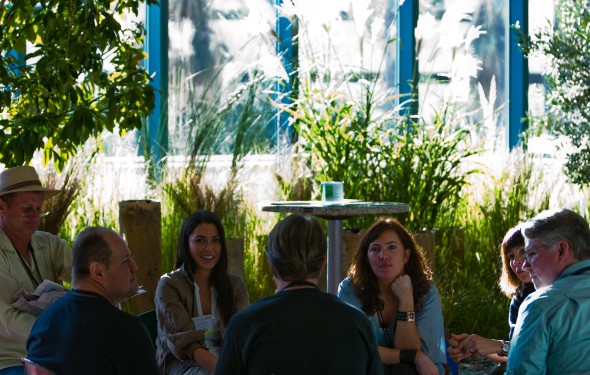In part one of this piece, I discuss the various ways that nonprofit organizations can benefit from sharing relationships with each other and with their supporters. But how can we foster a sharing revolution among nonprofits? My suggestions:
- Identify organizations’ shareable assets and capabilities: We live in a world filled with underused resources. Nonprofits often have closets full of unused equipment, office spaces that aren’t in use, or staff whose talents are not fully used or appreciated. Doing an inventory of these assets – perhaps through a group brainstorm – is a good place to start.
- Identify areas of need and come up with shareable ways to meet those needs: Many organizations have the same general need right now – the need to cut costs and do more with less. A good way to identify needs is to look at items the nonprofit is spending the most money on, and strategize on ways to share down those costs.
- Find sharing partners: Here’s the hard part. In the example above, it’s hard to say how a crisis hotline and environmental group would have a) found each other, b) communicated their needs to each other, and c) figured out that they could meet them through sharing.
Nonprofits could use help with all of these tasks, especially the third. That’s why I think nonprofits could greatly benefit from websites, organizations, and events that are organized specifically to make sharing connections. This could happen online, through websites similar to VCS Collaborate (a UK-based online community that connects organizations to one another and facilitates the sharing process), or a similar site in India, KarmaYog, which allows nonprofits to post needs and offerings in order to find and collaborate with each other.
As far as I know, there aren’t any comparable websites in wide use in the US, but I would to have them brought to my attention (i.e. leave a comment below please!)
 Off the internet, there could be events that are organized specifically to bring nonprofits together to discuss needs and ways to help each other – something akin to a gift circle. It makes most sense to make such events regionally focused, since proximity is a practical and powerful catalyst for sharing. Anyone up for a Berkeley nonprofit sharing conference?
Off the internet, there could be events that are organized specifically to bring nonprofits together to discuss needs and ways to help each other – something akin to a gift circle. It makes most sense to make such events regionally focused, since proximity is a practical and powerful catalyst for sharing. Anyone up for a Berkeley nonprofit sharing conference?
In addition, nonprofit capacity-building and infrastructure organizations (such as the Council of Nonprofits or the Nonprofit Technology Network, to name a couple) could facilitate sharing by connecting member organizations to each other, helping them draft written agreements, providing help administrating sharing arrangements, and so on.
In some cases, the sharing that takes place between nonprofits will call for the formation of a separate entity, such as a joint venture, a co-op, or a nonprofit mutual benefit organization. Typically, this should happen if there is significant value or liability at stake, or if organizations stand to be seriously put out if another organization bails.
One example of a separate entity is the The Milwaukee Environmental Consortium, a membership organization comprised of 15-20 environmental nonprofits. The Consortium “provides communal office services and is a conduit for communal benefits to its members.” The Consortium was formed so that organizations could jointly build a shared office space. Now that the space has been constructed, the Consortium continues to facilitate sharing arrangements of all kinds.
Six Things to Think About When Sharing
For a nonprofit ready to start sharing, here are a few things to think about:
1. Due diligence: Before entering into a sharing agreement, a nonprofit should conduct due diligence, especially making sure that the other party has the resources and capacity to uphold their end of the deal.
2. The sharing agreement: Getting a sharing agreement in writing is crucial for nonprofits, and will help to ensure that everyone remains accountable to a sharing plan, even if there is turnover in staff. There are many things to include in the agreement about how to share, but a very important one is how to un-share – in other words, the exit plan. To the extent that sharing fills a gap, un-sharing will create a gap, unless parties plan for it.
3. Managing sharing relationships: It’s also important to manage sharing relationships, especially if an organization has lots of them. Coming up with a system for tracking what is shared, ensuring that it is accounted for in the books, keeping records of transactions, and checking in with sharing partners are all important tasks that must come with sharing.
4. Tax-exempt purposes: The sharing arrangement must not result in activities that deviate significantly from the organization’s corporate and tax-exempt purposes (the purposes stated in governing documents and on which basis the IRS granted tax exemption). If a sharing activity does deviate and also results in “income” for the nonprofit, it’s important to determine whether any unrelated business income tax could be due on that income.
5. Avoiding private benefit: When sharing with private individuals or businesses, a nonprofit should be careful to avoid improper private benefits. The sharing arrangement may benefit private parties, but the nonprofit’s main purpose in sharing should be to further the tax-exempt purposes, and any benefits to private parties must be incidental. In addition, the sharing arrangement should be a fair deal for the nonprofit and bargained for at arm’s length, or it could be seen as an improper excess benefit transaction. Thus, it’s a good idea to make sure that the cost of a sharing arrangement for a nonprofit is either equivalent to or less than market rates. In the case of the theater company asking people to donate their garage space, it’s conceivable that the nonprofit could offer to pay a small amount of rent for the space, but preferably at a rate far lower than what they’d pay for a commercial storage unit.
6. Tax-benefits?: In case you are wondering whether there are any tax-benefits for private individuals or businesses who share by lending space or goods, the answer is: probably not. There may be some exceptions I’m not aware of, but in general any in-kind donation that is either partial or temporary cannot be written off as a charitable contribution. Thus, in the case of the theater company above, the homeowners could not write off the value of the garage space they lend. (But the warm fuzzies that come from the homeowner’s generosity are priceless to everyone!)
A Note to New Nonprofits
While “strategic restructuring” can be difficult for existing organizations, new nonprofits have an opportunity to have strategic and smart structuring from the outset. A great way to launch a new nonprofit on a shoestring is to share another organization’s tax-exemption, either by becoming a fiscally sponsored program of that nonprofit, or by becoming a chapter organization and thereby falling under a parent organization’s group tax exemption.
Also, anyone forming a new nonprofit organization should contact existing nonprofits or for profit business, and inquire about sharing space. It might be a cost saver to everyone involved and provide all kinds of added resources for the new organization.
Other Creative Sharing Possibilities?
Do you have examples of creative ways that nonprofits can or do share with businesses, with individuals, or with other nonprofits? We’d love it if you’d leave a comment below and share that idea! The more ideas we collect, and the more everyone in the nonprofit world starts murmuring about sharing, the less we have to speculate about the frightening fate of nonprofits in this economy. The nonprofit sector is not going to crash and burn – it’s going to share.









